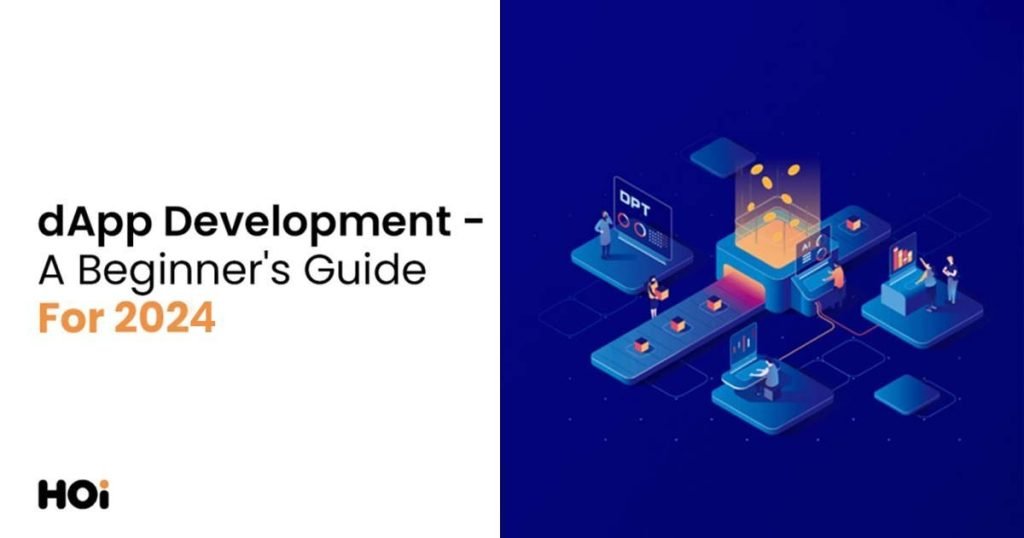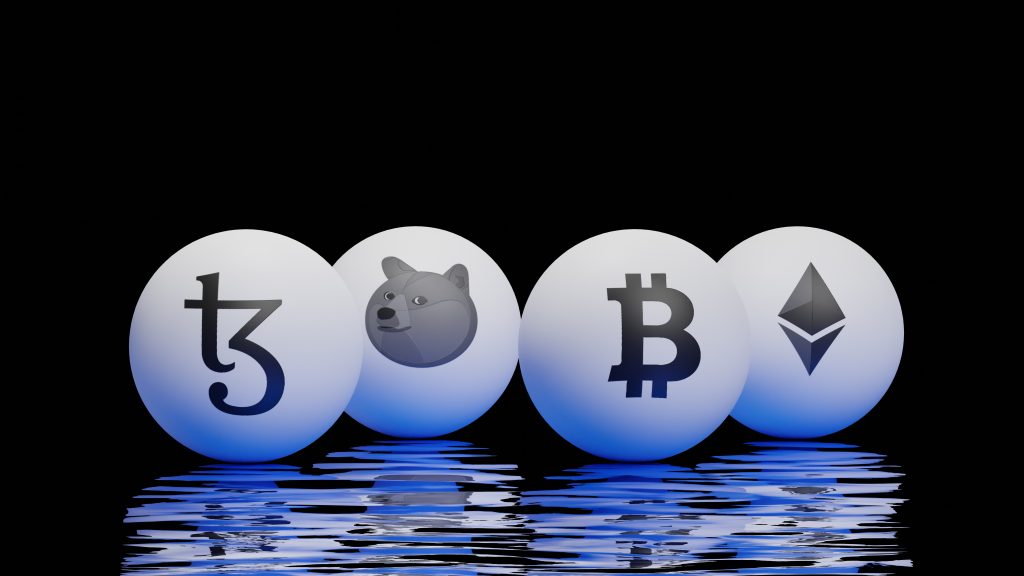dApp Development – A Beginner’s Guide For 2024

A dApp, or decentralized application, is a type of software application that operates on a decentralized network of computers rather than being controlled by a single, centralized entity. Unlike traditional applications, these apps operate on a distributed network instead of relying on centralized servers.
Today, decentralized applications have indeed become a focal point in the rapidly growing landscape of blockchain technology. As the global blockchain market projects substantial growth, reaching $69.04 billion by 2027, the demand for dApp development services is witnessing a significant surge.
In this article, we’ll explore what dApps are, and how are they different than regular apps. We’ll talk about the key features and benefits of dApp development. We will also discuss how to create a simple but effective dApp. Let’s begin.

What Is dApp Development?
dApp development is the process of constructing decentralized applications, where the backend code operates on a decentralized peer-to-peer network. In this innovative approach, the traditional reliance on centralized servers is replaced by a distributed network of interconnected computers. This design not only enhances security but also promotes transparency and resilience.
At the heart of dApp development is the utilization of smart contracts, self-executing code that automates and enforces predefined rules within the application. This transformative shift in the development landscape, often facilitated on blockchain platforms like Ethereum, highlights the potential for decentralized applications to revolutionize various industries.
Decentralized Applications Vs. Traditional Applications: Which Are Better?
The decision between traditional applications and dApps necessitates careful consideration of their respective limitations and benefits, each playing a distinctive role and employing unique methodologies in their creation.
Although traditional applications currently maintain a higher level of popularity compared to dApps, the domain of dApp development services is gaining recognition and growing in demand.
Here are some of the key differences between a dApp and an app that you should know about:
dApp (Decentralized Application) | App (simply, Application) |
|
|
|
|
|
|
|
|
|
|
|
|
|
|
|
|
|
|
|
|
Future-proof your business with our dApp development expertise.
Experience the benefits of decentralization. Start your project today!
What Are The Key Features Of dApp Development?
Now that you know what blockchain dApp development is and how is it different from your regular mobile applications, you must also know its characteristics that contribute to its eccentric nature and highlight its need in the technological field:

1. Open Source
An open-source decentralized app (dApp) is easily understandable and accessible to users and readily gains their trust. For a dApp to be considered legitimate, it must adhere to the principles of being open-source, free from centralized control, autonomous in operation, and its code must be accessible for scrutiny by anyone.
In contrast to conventional applications, dApps don’t require users to reveal their true identities for registration or interaction. User data is stored in a shared database that remains beyond the influence of any central authority, and only the user holds the decryption capability.
2. Decentralized Entity
Decentralization is a core aspect. Operational records must be stored on a decentralized blockchain network.
The data within a dApp is stored on a decentralized blockchain, providing users with the convenience and anonymity to conduct transactions and connect their user sessions and metadata using a combination of public and private keys, thereby eliminating the necessity for extensive sign-up or registration processes.
Since blockchain networks are maintained by multiple users, the actions taken on these networks are not under the authority of any single individual or government entity.
3. Immediate Services
Decentralized applications, or dApps, have introduced a range of innovative services that were previously inaccessible through traditional means. One notable advancement is the facilitation of swift payment methods and microtransactions using cryptocurrency wallets.
These dApps empower users to make payments for a wide array of services, including online shopping, ride-sharing, food delivery, and more, with remarkable speed and efficiency. Gone are the days of waiting for prolonged transaction processing times or seeking opportune exchange rates; dApps offer the flexibility to pay for your needs instantly and at your convenience.
This transformative shift in the digital landscape not only enhances user experience but revolutionizes various aspects of everyday life.
4. Protocol Complaint
Protocol adherence is essential for dApps, as their stakeholders need to reach a consensus on a cryptographic algorithm for demonstrating the proof of value. For instance, both Bitcoin and Ethereum currently employ the Proof of Work consensus protocol, although Ethereum has plans to transition to Proof of Stake in the coming years.

5. Incentivized
To motivate participation, a dApp should have the capability to create tokens as a form of proof of value and distribute these tokens as incentives within the network. The primary driving force behind the development of mainstream dApps often revolves around financial gains for users, rather than ownership stakes. Nevertheless, in many instances, the users themselves end up becoming the de facto owners of these applications.
The architecture of A dApp development company carefully designs their dApps to provide users with incentives, typically in the form of tokens, to ensure the security, transparency, and optimal functionality of the dApp. Importantly, dApp development services are globally accessible to a vast majority of the population through the Internet.
Benefits Of Decentralized Applications
Decentralized applications (dApps) offer several advantages that set them apart from traditional, centralized applications. Here are some key benefits of decentralized applications:
1. Anonymity
Users can enjoy full anonymity since dApps generally do not necessitate lengthy registration procedures, thereby offering privacy and granting users greater control over their personal information.
In the realm of dApps, real identity verification is typically unnecessary; instead, users can access these applications with just an Ethereum login and a digital wallet, eliminating the need for extensive signup procedures while preserving user privacy and control.
2. Uninterrupted Accessibility
dApps function within a peer-to-peer network, guaranteeing uninterrupted service. Even when individual computers become disconnected, the network remains unaffected.
This stands in stark contrast to centralized applications, exemplified by recent incidents where platforms such as Facebook, WhatsApp, and Instagram suffered prolonged service disruptions.
3. Censorship Resistance
dApps are impervious to government or entity attempts to restrict user access. No single entity wields sufficient authority to govern the network, obstruct user transactions, hinder application deployment, or access blockchain data.
In essence, if Instagram or Twitter operated on the Ethereum platform, no one could impede your posts or prevent you from tweeting.
4. Reliable Entity
The robust reliability of dApp data records owes itself to the remarkable qualities of transparency and immutability facilitated by blockchain technology. This inherent transparency allows users to delve into the blockchain’s public ledger and independently scrutinize every transaction, ensuring a high level of trust in the system.
This combination of transparency and immutability not only enhances user confidence but also fosters a sense of accountability within the dApp ecosystem, as all participants can verify the accuracy and legitimacy of the recorded data, ultimately contributing to the trustworthiness of decentralized applications.
How To Develop dApps? A Step-By-Step Guide
The blockchain landscape is opening up a wealth of fresh opportunities for businesses. If you seek heightened transparency, security, and efficiency, the emergence of blockchain technologies and dApps is sure to capture your interest.
Now, you might be pondering the process of building a dApp development and how it differs from traditional custom software development. To gain insight into each of the steps involved, let’s get into the development process for decentralized applications by a dApp development company itself:
1. Define The Problem
To begin, it is essential to pinpoint the specific challenge you aim to address or put differently, the practical application for your prospective dApp. Begin by delineating the obstacles you encounter and evaluating whether a decentralized application can provide a solution.
Are you interested in eliminating intermediaries from your transactions? Alternatively, do you seek to disperse information and services from a centralized hub? Regardless of your objective, the initial step involves determining the problem that a dApp can potentially resolve for you.
2. Come Up With A Proof-Of-Concept
Subsequently, it becomes imperative to generate a Proof of Concept (POC) to validate your concept and demonstrate its viability. In essence, this POC serves as a means to test your dApp with minimal resource investment before embarking on the more extensive and resource-intensive development phase.
Approach this stage diligently, as it offers valuable insights into potential challenges and areas where enhancements may be required.
3. Pick A DLT (Distributed Ledger Technology) Platform
In the event of a successful POC, the next step is to shift your focus toward execution. Given the array of platforms available for dApp development, it is crucial to pinpoint the one that aligns best with your needs. Each blockchain platform boasts its own set of advantages and constraints, necessitating a thorough evaluation to determine which one suits your requirements.
At present, Ethereum often stands out as a highly suitable choice, thanks to its robust smart contract capabilities. Nevertheless, conducting your research is essential to ensure that you select the platform that best aligns with your specific objectives and preferences.
4. Develop And Test Your dApp
Once you’ve selected a Distributed Ledger Technology (DLT) platform, you can proceed with the development and testing phases of your decentralized application. Whether you opt for custom application development services or employ an in-house team, it is imperative to subject your dApp to comprehensive testing.
After all, you wouldn’t want to encounter avoidable issues upon launching your new software.
5. Hit The Launch Button For Your dApp
Lastly, after thorough testing, your dApp is prepared for launch! It’s crucial to exercise utmost caution when deploying it on the production server, as there’s minimal room for errors in this phase. As you may recall, making alterations becomes challenging once the application is live, so it’s essential not to rush through this process.
While these are overarching steps, it’s important to note that the technical aspects are considerably more intricate. You need not navigate the complexities of dApp development on your own; instead, consider seeking assistance from seasoned professionals to guide you through the intricacies of blockchain-based dApp development.
Conclusion
In conclusion, getting into dApp development unfolds a fascinating journey into the future of technology. As outlined in this comprehensive guide, the unique attributes of decentralized applications, from enhanced security to transparency and autonomy, showcase the transformative potential of blockchain technology.
Whether you’re a beginner seeking insights or a business aiming to harness the benefits, understanding the intricacies of dApp development positions you at the forefront of technological innovation.
To further explore the world of blockchain technology, read our blog on “What is Blockchain Technology and How Does it Work.”
Have more questions? HOI Solutions is here to help you out.
Ready to lead in the decentralized era? Partner with us for top-notch dApp development services that redefine the way you do business.
FAQs
What are dApps?
Decentralized applications, often referred to as dApps, represent the pinnacle of blockchain technology’s capabilities. Through the utilization of decentralized networks, dApps empower users to partake in transparent interactions, effectively removing the necessity for intermediaries. Through the use of dApps, individuals can assert authority over their data and transactions, ushering in a fresh era characterized by autonomy and empowerment.
How are dApps different from traditional apps?
Distributed applications, or dApps, distinguish themselves from conventional apps by functioning on decentralized networks such as blockchain. They provide unparalleled transparency, immutability, and heightened security. Users maintain ownership of their data, and transactions are not reliant on a centralized governing entity.
What does a dApp development company do?
A dApp development company, such as HOI Solutions, specializes in the design and development of decentralized applications (dApps) that prioritize security and scalability. Our expertise extends across a broad spectrum of industries, and we have a particular emphasis on key sectors such as DeFi (Decentralized Finance), NFTs (Non-Fungible Tokens), and gaming. Our commitment is to provide tailored solutions that empower businesses to thrive in the decentralized landscape and capitalize on the immense potential of blockchain technology.
How much does dApp development cost?
The cost of dApp development is subject to fluctuation based on factors like project complexity, feature set, platform choice, and the duration of development. We encourage you to get in touch with us for a customized and precise cost estimate that aligns perfectly with your unique project needs.

